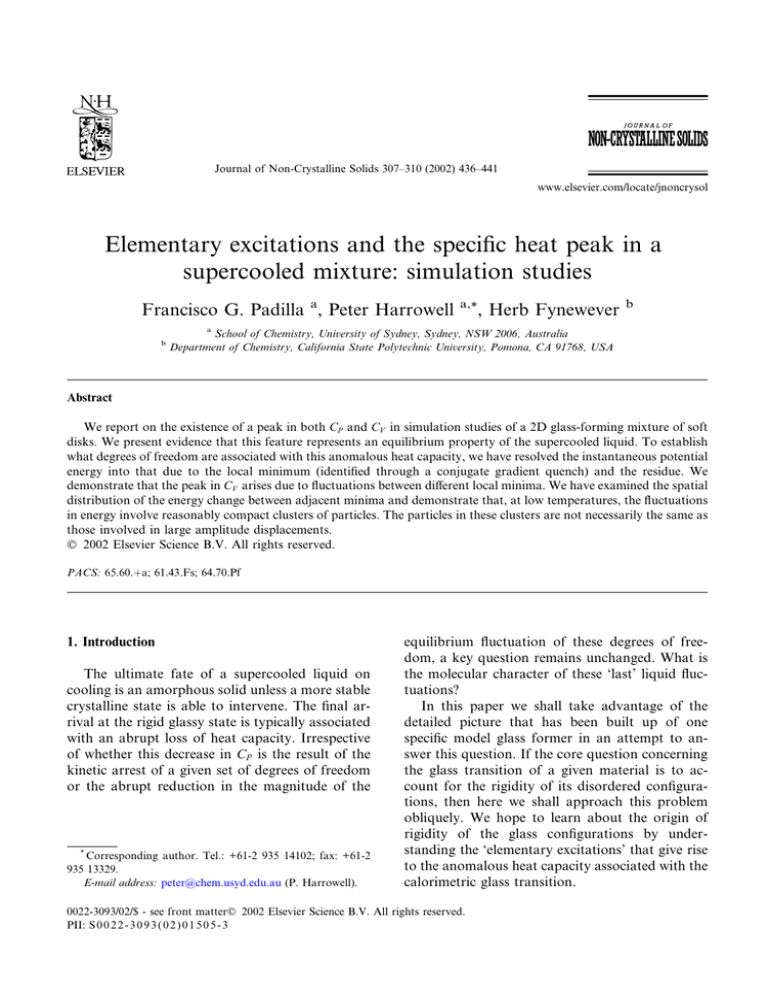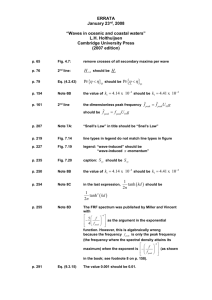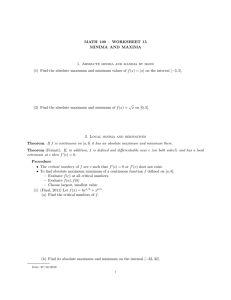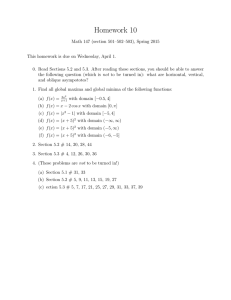
Journal of Non-Crystalline Solids 307–310 (2002) 436–441
www.elsevier.com/locate/jnoncrysol
Elementary excitations and the specific heat peak in a
supercooled mixture: simulation studies
Francisco G. Padilla a, Peter Harrowell
b
a,*
, Herb Fynewever
b
a
School of Chemistry, University of Sydney, Sydney, NSW 2006, Australia
Department of Chemistry, California State Polytechnic University, Pomona, CA 91768, USA
Abstract
We report on the existence of a peak in both CP and CV in simulation studies of a 2D glass-forming mixture of soft
disks. We present evidence that this feature represents an equilibrium property of the supercooled liquid. To establish
what degrees of freedom are associated with this anomalous heat capacity, we have resolved the instantaneous potential
energy into that due to the local minimum (identified through a conjugate gradient quench) and the residue. We
demonstrate that the peak in CV arises due to fluctuations between different local minima. We have examined the spatial
distribution of the energy change between adjacent minima and demonstrate that, at low temperatures, the fluctuations
in energy involve reasonably compact clusters of particles. The particles in these clusters are not necessarily the same as
those involved in large amplitude displacements.
Ó 2002 Elsevier Science B.V. All rights reserved.
PACS: 65.60.þa; 61.43.Fs; 64.70.Pf
1. Introduction
The ultimate fate of a supercooled liquid on
cooling is an amorphous solid unless a more stable
crystalline state is able to intervene. The final arrival at the rigid glassy state is typically associated
with an abrupt loss of heat capacity. Irrespective
of whether this decrease in CP is the result of the
kinetic arrest of a given set of degrees of freedom
or the abrupt reduction in the magnitude of the
*
Corresponding author. Tel.: +61-2 935 14102; fax: +61-2
935 13329.
E-mail address: peter@chem.usyd.edu.au (P. Harrowell).
equilibrium fluctuation of these degrees of freedom, a key question remains unchanged. What is
the molecular character of these ‘last’ liquid fluctuations?
In this paper we shall take advantage of the
detailed picture that has been built up of one
specific model glass former in an attempt to answer this question. If the core question concerning
the glass transition of a given material is to account for the rigidity of its disordered configurations, then here we shall approach this problem
obliquely. We hope to learn about the origin of
rigidity of the glass configurations by understanding the ‘elementary excitations’ that give rise
to the anomalous heat capacity associated with the
calorimetric glass transition.
0022-3093/02/$ - see front matterÓ 2002 Elsevier Science B.V. All rights reserved.
PII: S 0 0 2 2 - 3 0 9 3 ( 0 2 ) 0 1 5 0 5 - 3
F.G. Padilla et al. / Journal of Non-Crystalline Solids 307–310 (2002) 436–441
2. The model and algorithm
In previous papers [1–3], we have established
that a binary mixture of soft disks in 2D reproduces all of the main phenomenological features of
a fragile glass former. The system consists of an
equimolar mixture of two types of particles with
diameters r11 ¼ 1:0 and r22 ¼ 1:4 with the same
mass m. The three pairwise additive interactions
are given by the purely repulsive soft-core potentials uab ðrÞ ¼ eðrab =rÞ12 where a and b refer to
species 1 or 2 and r12 ¼ ðr11 þ r22 Þ=2. The cutoff
radii of the interactions are set at 4.5rab . The units
of mass, length and time are m, r11 and s ¼ r11 ðm=
1=2
eÞ respectively.
A total of N ¼ 1024 particles were enclosed in
a square box with periodic boundary conditions.
The simulations were carried out at constant
number of particles, pressure P ¼ P r211 =e and
temperature T ¼ TkB =e where kB is Boltzmann’s
constant. The constraint molecular dynamics
(MD) algorithm of Evans and Morriss [4] was
used. In this method, the instantaneous kinetic
energy and pressure are strict constants of the
motion. The system is initially driven to the desired temperature and pressure through the scaling of momenta and volume, respectively, using
a Newton–Raphson convergence scheme. A thirdorder (four-value) gear predictor–corrector algorithm was used to integrate the equations of
motion [5]. The time step employed was 0.005s.
The pressure was fixed at P ¼ 13:5. For T P
0:4, the equilibration times were longer than the
times taken for all the dynamic correlation functions investigated to decay to zero. Below T ¼
0:4, however, the system is no longer able to reach
equilibrium within the finite time scale of the experiment. For these low temperatures, the equilibration run was taken out until steady state was
achieved, i.e. when the average thermodynamic
properties remained constant. The heat capacities
were calculated using the fluctuation formulae
CP =NkB ¼ 1 þ
hDH 2 i
NT 2
at constant pressure
ð1Þ
hDE2 i
NT 2
at constant volume:
ð2Þ
and
CV =NkB ¼ 1 þ
437
Here, the symbol D indicates the difference between the instantaneous value of a quantity and
its mean value, DH ¼ DE þ P DV and E refers
specifically to the potential energy.
3. The CP peak as an equilibrium phenomenon:
system size effects
The presence of a peak in the specific heat
CP ð¼ CP =NkB Þ for the binary mixture of disks has
been reported elsewhere [1]. The run times used to
evaluate the values of CP for T P 0:4 are more
than 30 times the appropriate structural relaxation
time, obtained from the relaxation of the selfintermediate scattering function at the Bragg wavevector. On this basis, it was proposed that the peak
in CP corresponded to an equilibrium feature of
the supercooled liquid.
Here we report on the results of simulations of
a small system of 128 particles. These results are
relevant to the discussion of whether or not the
anomalous heat capacity is a kinetic effect. We find
that the structural relaxation time exhibits a significant increase in the small systems over that of
the large system at low temperatures. We can find
no analogous difference in CP between the large
and small systems, supporting the contention that
the specific heat peak is an equilibrium feature.
The intermediate scattering function FS ðk1 ; tÞ
*
+
N1
n
h
io
1 X
FS ðk1 ; tÞ ¼
exp i~
k1 ~
rj ðtÞ ~
rj ð0Þ
N1 j¼1
ð3Þ
is plotted in Fig. 1 for T ¼ 0:3, 0.4 and 0.5 from
systems with N ¼ 1024 and N ¼ 128. The wavevector ~
k1 corresponds to the first peak in the
scattering function from species 1. At T ¼ 0:4 we
find the smaller system exhibits a relaxation that is
approximately an order of magnitude slower than
the larger system. Kim and Yamamoto [6] have
reported a similar size dependence in the relaxation time of a mixture of soft spheres. To propose
that the step in CP is due to the kinetic arrest of
some degrees of freedom implies that the temperature of the peak in the heat capacity corresponds to the state in which the time scale of
438
F.G. Padilla et al. / Journal of Non-Crystalline Solids 307–310 (2002) 436–441
higher temperatures that would be expected
should the feature be due to kinetic effects.
4. CV and the change in potential energy fluctuations
Fig. 1. The specific heat CP as a function of temperature for
N ¼ 1024 and N ¼ 128. Note the peak at T 0:5 that can be
seen for both the large and small systems.
structural relaxation is of a similar magnitude to
the time scale over which CP is calculated. An increase in the structural relaxation time, therefore,
should result in an increase in the temperature at
which the step in the heat capacity is observed. In
Fig. 2 we have plotted the values of CP for the
large and small systems. Apart from a possible
increase in the value of CP around the peak temperatures in the smaller system, we can find no
evidence of a shift in the heat capacity peak to
Fig. 2. The incoherent scattering function FS ðk1 ; tÞ as a function
of time for N ¼ 128 (thick line) and N ¼ 1024 (thin line) at
three temperatures. From left to right, the temperatures are
T ¼ 0:5, 0.4 and 0.3. Note the significant slowing down in the
small system with respect to the large system seen at T ¼ 0:4.
To proceed in analysing the role of individual
particles in contributing to the heat capacity, we
need to shift focus to the heat capacity at constant
volume. This quantity does not include the volume
fluctuations, global variations that defy any unique assignment to individual particles. Under the
conditions of the simulation of fixed kinetic energy, the non-trivial part of CV ð¼ CV =NkB Þ can be
attributed completely to fluctuations in the potential energy. This allows us to directly associate
changes in the specific heat to changes in particle
behaviour. First, of course, we must establish that
CV exhibits a peak similar to that observed in CP .
This point is confirmed by the results plotted in
Fig. 3. The calculations of CV where carried out at
volumes fixed to the average values obtained in the
constant pressure calculations. In order to compare these CV with CP the former has been evaluated along the isobar of P ¼ 13:5. Elsewhere [7],
we have confirmed that these two heat capacities
obey the thermodynamic relation CP ¼ CV þ
TV a2P =jT , where aP is the thermal expansion coefficient and jT is the isothermal compressibility.
Fig. 3. The specific heats CP and CV as a function of T for an
equimolar mixture of 1024 particles. Note that CV exhibits a
similar peak to that seen in CP .
F.G. Padilla et al. / Journal of Non-Crystalline Solids 307–310 (2002) 436–441
439
Next, we shall resolve the instantaneous potential energy into two components E ¼ Eo þ ER .
Here Eo corresponds to the value of the energy of
the local potential minimum located by a conjugant gradient minimisation procedure. ER is simply the residual energy. The potential component
of the heat capacity CV 1 can be written as a
sum of three terms,
CV 1 ¼ CV ðoÞ þ CV ðcrossÞ þ CV ðRÞ;
ð4Þ
where
CV ðoÞ ¼ hDEo2 i=NT 2 ;
ð5Þ
CV ðcrossÞ ¼ 2hDEo DER i=NT 2 ;
ð6Þ
and
CV ðRÞ ¼ hDER2 i=NT 2 :
ð7Þ
The three terms in Eq. (1) can be interpreted as
follows. CV ðoÞ represents the contribution associated with fluctuations between different local
minima. CV ðRÞ is the contribution due to energy
fluctuations within a single minimum, the so-called
‘vibrational’ contribution. CV ðcrossÞ represents the
cross-correlation between the two components of
the potential energy. It is standard to assume that
this last term is zero in order to treat fluctuations
within a given local potential well as uncorrelated
with fluctuations between different potential wells.
In Fig. 4 we present the values of each of the three
components of CV 1. These have been calculated
over a 5000s runs with the local minimum located
every 10s. As the temperature decreases, the number of uncorrelated minima will drop.
Referring to Fig. 4 we find that the peak in CV
can, in its entirety, be attributed to a peak in CV ðoÞ
and, hence, to fluctuations between minima. The
cross correlation term CV ðcrossÞ is, indeed, close to
zero while the vibrational component CV ðRÞ remains consistently close to one, the value expected
for harmonic oscillations. This demonstration that
the peak in CV is a direct consequence of the
fluctuations between potential minima underscores
the core issue posed by the existence of these local
basins.
Fig. 4. The potential energy components of the heat capacity
CV : CV ðoÞ, CV ðcrossÞ and CV ðRÞ as defined in the text. The peak
in CV can be attributed entirely to the peak in CV ðoÞ.
5. The shape and spectrum of the elementary
excitations
Taking advantage of the 2D model, we can directly identify which particles are involved in the
transition between minima. A map of the particle
displacements between two adjacent minima at
T ¼ 0:3 is shown in Fig. 5 in the form of line
segments. The highly correlated nature of the large
displacements (note the loop-like arrangement of
displacements in the lower right quadrant) has
been noted previously by a number of workers [8].
Here we consider whether these particles are also
the ones contributing most to the potential energy
change between local minima.
We have examined the change in potential energy of each particle as the system moves between
the two minima. In Fig. 5 we have marked with
circles the 60 particles with the largest magnitude
energy changes, both increases and decreases, for
the same configurational transition. There are a
number of points of interest in Fig. 5. The energy
changes show a strong tendency to cluster in space,
consistent with the movement between landscape
minima being associated with localised rearrangements. Significant energy changes occur in the
440
F.G. Padilla et al. / Journal of Non-Crystalline Solids 307–310 (2002) 436–441
Fig. 5. Particle displacements (indicated as line segments) between two configurations corresponding to sequential local
minima at T ¼ 0:3. Note the correlated loop motion. The
particles indicated by circles correspond to those particles that
undergo the largest changes in potential energy in the transition
between the two local minima. The indicated particles make up
50% of the total change in energy.
absence of a local large displacement of particles.
The heterogeneity of energy changes, therefore,
provides information complimentary to that of
spatial displacements. In fact, we find that particles undergoing large displacements between minima are not, typically, associated with large energy
changes.
We have defined a ‘single excitation’ as a transition between minima 50% of whose energy
change can be ascribed to a single connected
cluster of particles. The distribution of the energy
change associated with such ‘single’ events at
T ¼ 0:3 is plotted in Fig. 6. To extract a density of
states associated with these configurational excitations, we have assumed that they can be treated
as uncoupled excitations of an amorphous ground
state. We can then relate the probability gðdÞ of
finding an excitation with an excitation energy d
to the observed transition probability P ðDEÞ (DE
here, referring to the energy change between local
minima) through the relation
P ðDEÞ ¼
gðDEÞ
1
:
2
2 cosh ðDE=2T Þ
ð8Þ
Can we use the excitation spectrum of the ground
state obtained at a low temperature to describe the
thermal behaviour of the amorphous system over
Fig. 6. The distribution of energy changes (in units of e) between sequential minima at T ¼ 0:3. Only those transitions
involving a single cluster of particles exhibiting large energy
changes were included in this distribution.
a range of temperatures? This utility is, of course,
the attraction of elementary excitation representations in condensed matter theory. We have calculated the contribution of fluctuations between
potential minima to the heat capacity, i.e. the term
CV ðoÞ, based on the value of gðDEÞ obtained at
T ¼ 0:3 using Eq. (8). The comparison of this
estimate with the value of CV ðoÞ obtained directly
from simulations is presented in Fig. 7. Clearly the
Fig. 7. A comparison of the component of the heat capacity
CV ðoÞ evaluated directly from simulations (the open circles with
a line to guide the eye) and the calculation of CV ðoÞ (line
without symbols) assuming a distribution gðDEÞ of uncoupled
two-state excitations. The distribution gðDEÞ was obtained
from the distribution P ðDEÞ at T ¼ 0:3 as described in the text.
F.G. Padilla et al. / Journal of Non-Crystalline Solids 307–310 (2002) 436–441
characteristic temperature of the excitation model
is too high. This suggests that coupling between
excitations results in significant ‘softening’ of the
amorphous state with an associated reduction in
the energy cost of configurational excitations.
6. Conclusion
In this paper we have reported on progress in
resolving the molecular fluctuations associated
with peak in the specific heat of a glass-forming
binary mixture in 2D. Our main result is to have
confirmed that the peak in CV is the result of a
peak in the component of the heat capacity arising
from fluctuations in energy of the local minimum.
This result is consistent with the recent results of
Sastry and co-workers [9] in a binary mixture in
3D who found that the maximum in dhE0 i=dT was
associated with a change between liquid-like and
glassy-like dynamics. While we find the excitation
picture to be a realistic summary of the localised
character of the configurational transitions, an
uncoupled model of these excitations appears to
be too simple to usefully describe the thermal
behaviour of the amorphous state.
Taking advantage of the ease of visualisation in
2D, we have examined the spatial distribution of
the energy change associated with the transitions
between potential minima. We find these transitions between inherent structures to involve compact clusters of particles. There is a non-trivial
correlation between those particles involved in
the large displacements associated with dynamic
441
heterogeneities and those involved in the energy
changes that give rise to the peak in CV . Specifically, we find that regions of large energy change
either do not coincide with those particles undergoing large displacements or, if they do, it is with
particles engaged in localised loops. Particles associated with extended linear ‘shunting’ motions
typically do not make any significant direct contribution to the fluctuation in potential energy of
the local minima. We are currently examining
this molecular level correlation between thermodynamics and transport in the glass-forming liquid.
Acknowledgements
This work has been supported by a grant from
the Australian Research Council.
References
[1] D. Perera, P. Harrowell, Phys. Rev. E 59 (1999) 5721.
[2] D. Perera, P. Harrowell, J. Chem. Phys. 111 (1999) 5441.
[3] H. Fynewever, P. Harrowell, J. Phys.: Condens. Matter 12
(2000) 6305.
[4] D. Evans, G. Morriss, Chem. Phys. 77 (1983) 63;
D. Evans, G. Morriss, Comp. Phys. Rep. 1 (1984) 297.
[5] M. Allen, D. Tildesley, Computer Simulations of Liquids,
Oxford University, Oxford, 1987.
[6] K. Kim, R.Yamamoto, cond-mat/9903260, 1999.
[7] H. Fynewever, F.G. Padilla, P. Harrowell, in preparation.
[8] M. Hurley, P. Harrowell, Phys. Rev. E 52 (1995) 1694;
R. Yamamoto, A. Onuki, Phys. Rev. Lett. 81 (1998) 4915;
C. Donati et al., Phys. Rev. Lett. 80 (1998) 2338;
C. Donati et al., Phys. Rev. E 60 (1999) 3107.
[9] S. Sastry, P. Debenedetti, F. Stillinger, Nature 393 (1998) 555.





